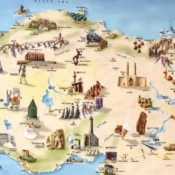Tours in Historical Information
Exploring Turkey’s Rich Historical Tapestry
Introduction
Turkey, a land bridging two continents, boasts a history as diverse as its landscapes. From ancient civilizations to modern times, the region has been a crossroads of cultures, empires, and religions. This article delves into the key historical epochs that have shaped Turkey’s unique identity.
Ancient Civilizations
The Hittites
One of the earliest known civilizations in Anatolia, the Hittites established a powerful empire around 1600 BCE. Centered in Hattusa (near modern-day Boğazkale), they were renowned for their advanced legal systems and military prowess.
Phrygians and Lydians
Following the Hittites, the Phrygians and Lydians rose to prominence. The Phrygians, with their capital at Gordion, are often associated with the legendary King Midas. The Lydians, based in Sardis, are credited with inventing coinage, revolutionizing economic systems.
Greek Colonization
The western coast of Anatolia witnessed extensive Greek colonization. Cities like Ephesus, Miletus, and Smyrna became centers of trade, philosophy, and art, leaving an indelible mark on the region’s cultural landscape.
The Byzantine Era
Rise of Byzantium
In 330 CE, Emperor Constantine I established Constantinople (modern-day Istanbul) as the new capital of the Roman Empire. This strategic move heralded the Byzantine era, during which the city became a bastion of Christianity and a hub of commerce and culture.
Cultural and Religious Significance
During the Byzantine period, monumental structures like the Hagia Sophia were constructed, exemplifying architectural brilliance. The empire also played a pivotal role in preserving classical knowledge and fostering the spread of Orthodox Christianity.
The Seljuk and Ottoman Periods
Seljuk Turks
Originating from Central Asia, the Seljuk Turks began migrating into Anatolia in the 11th century. Their victory at the Battle of Manzikert in 1071 opened the region to Turkish influence, setting the stage for future empires.
Foundation of the Ottoman Empire
In the late 13th century, Osman I founded the Ottoman Empire in Anatolia. Over the next six centuries, the Ottomans expanded their dominion across Southeast Europe, Western Asia, and North Africa, leaving a profound legacy on law, architecture, and culture.
Golden Age and Decline
Under rulers like Suleiman the Magnificent, the empire reached its zenith, marked by territorial expansion and cultural flourishing. However, internal strife and external pressures led to a gradual decline, culminating in the empire’s dissolution after World War I.
The Birth of Modern Turkey
War of Independence
In the aftermath of World War I, Turkish nationalists, led by Mustafa Kemal Atatürk, waged the War of Independence against occupying forces. Their victory resulted in the establishment of the Republic of Turkey in 1923.
Atatürk’s Reforms
As the republic’s first president, Atatürk implemented sweeping reforms to modernize Turkey. These included the adoption of the Latin alphabet, secularization of the state, and advancements in education and women’s rights.
Preservation of Historical Sites
UNESCO World Heritage Sites
Turkey is home to numerous UNESCO World Heritage Sites, such as Göbekli Tepe, Ephesus, and Cappadocia. These sites offer glimpses into the country’s multifaceted past and attract scholars and tourists alike.
Ongoing Archaeological Discoveries
Archaeological endeavors continue to unearth artifacts and structures, enriching our understanding of ancient civilizations that once thrived in the region.
Conclusion
Turkey’s history is a complex tapestry woven from myriad cultures, empires, and events. This rich heritage not only shapes the nation’s identity but also offers invaluable insights into human civilization’s evolution.
How did the people of Ephesus make a living
The Rich History and Geological Formation of Cappadocia: Civilizations, Beliefs, and Economy
All Categories
Quick insurance proccess
+9-0216-504-1680






